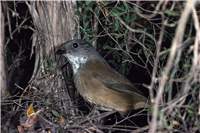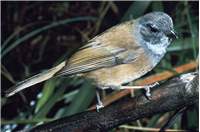Family
Pachycephalidae
Genus
Pachycephala
Species
olivacea
Threats/Control Methods - Regional
Land clearing and urban development pose the biggest threats to this forest-loving species. Clearing fragments their habitat areas and makes successful breeding difficult. It also limits the areas where they can find suitable shelter and food to survive. Intense bushfires and the invasion of introduced weeds and feral and uncontrolled domestic animals are also key threats. In NSW, control programs for feral cats (Felis catus) and foxes (Vulpes vulpes) are being undertaken.
Threats/Control Methods - Local
Those birds travelling into the suburbs or adjacent reserves are at risk from attacks by domestic dogs (Canis familiaris) and cats (Felis catus).
Local/Urban Actions
Taking action to revegetate the forest areas around the ACT is the best way to ensure this species survives locally. Groups such as Landcare often facilitate plantings, or check Greening Australia for upcoming events and ways to get involved.
Common Names
Olive Whistler, Olivaceous Whistler, Olive Thickhead
Distinguishing Features
This medium sized bird of 20-22cm is large for a whistler and has a superb song. It has a dark grey head and breast with a white and grey spotted throat. Its back and wings are red-brown with some black wing feathers. The underparts are a lighter brown. The females are similar but duller. Immature birds have paler heads and more red through the wings.
Survey Techniques
Call and visual identification.
Species Call
Strong whistles, either high and sharp or deep and mellow, ending with a whip-crack.
Similar Species
Female Golden Whistlers (Pachycephala pectoralis ) are slightly smaller and paler, with less brown colouring.
Distribution
These birds are only found in the very southeastern parts of Australia, especially on the south coast of VIC and in TAS. The range does reach up into southern QLD, however the birds are uncommon. More locally, the birds are found in the Brindabella Ranges.
Country of Origin
Australia
Conservation (Pet/Pest) Status - Regional
This species is considered Vulnerable in NSW. The species is very uncommon in the ACT, rarely moving in from the surrounding high country and only found here in the coldest months.
Conservation (Pet/Pest) Status - National
Secure, not listed under the EPBC Act 1999. The population of Glenelg Victoria (Pachycephala olivacea Hesperus) is considered Near Threatened, as numbers have halved due to land clearing.
LSCCES Population
A few birds were sighted on Black Mountain and the ANBG.
Associated vegetation community
The Olive Whistler prefers to inhabit the thick undergrowth of eucalypt forests or heath above about 500m altitude.
Limiting Resources
This species depends thick, shrubby ground vegetation for shelter and nesting.
Breeding
The breeding season takes place from September to January. The Olive Whistler builds a round, open cup nest in the thickest parts of forest undergrowth, typically up in a shrub about 1-2 metres off the ground. It is made from coarse twigs and lined with fine roots. A clutch consists of 2-3 white eggs with black and beige spots.
Behaviour
Olive Whistlers are difficult to find, as they hide on the ground in the thickest of vegetation. Listening for their musical song is the best way to find their location. This bird spends most of its time alone, although it can be spotted in the company of robins such as the Eastern Yellow Robin (Eopsaltria australis ) or the White-browed Scrubwren (Sericornis frontalis ).
Functional Group
Food Species
The Olive Whistler collects insects from the branches and leaves of thick vegetation; sometimes also eating seeds, berries and leaves.
Predators
This species is not prone to attacks from domestic pets, as it does not venture into the suburbs often. However, any feral animals such as the European Red Fox (Vulpes vulpes) may attack and kill Olive Whistlers.
Interesting Fact
The Olive Whistler is considered to have the most melodious call of all of the whistlers.
References - (reader suitability of references, P=Primary teachers, S=Secondary students, T=Tertiary students and researchers)
Books:Morcombe, M. 2000. Field Guide to Australian Birds. Steve Parish Publishing. Archerfield. Australia P, S, T
Schodde, R. and Tideman, S. (eds) 1990. Reader's Digest Complete Book of Australian Birds (2nd Edition). Reader's Digest Services Pty Ltd. Sydney. P, S, T
Veerman, P. 2003. Canberra Birds: A report on the first 21 years of the garden bird survey. Philip Veerman and Canberra Ornithologists Group. Canberra. S, T
Internet: Birds in Backyards. 2006. [online]. Available at:http://www.birdsinbackyards.net P, S, T
Department of Conservation and Environment (NSW). 2005. Threatened Species: Species, populations and ecological communities of NSW. Olive Whistler: Profile. [online]. Available at: http://www.threatenedspecies.environment.nsw.gov.au/tsprofile/profile.aspx?id=10583 P, S, T
Online Publications:ACT Government. 2004. Woodlands for Wildlife: ACT Lowland Woodland Conservation Strategy. Action Plan No. 27. Environment ACT, Canberra. [online]. Available at: http://www.environment.act.gov.au/nativeplantsandanimals/threatecspec/woodlandsstrategy S, T
Garnett, S. and Crowley, M. 2000. The Action Plan for Australian Birds 2000. Department of Environment and Water Resources. [online]. Available at: http://www.deh.gov.au/biodiversity/threatened/publications/action/birds2000/index.html S, T
Nix, H. and Cunningham, R. 2006. Birds of the Lower Sullivans Creek Catchment, Canberra ACT. Prepared for the Life in the Suburbs project using data from the Lower Sullivans Creek Catchment Ecological Survey (LSCCES). Australian National University. Canberra. [online]. Available at: http://www.lifeinthesuburbs.com.au/category.php?id=65 S, T


 Top
Top Top
Top